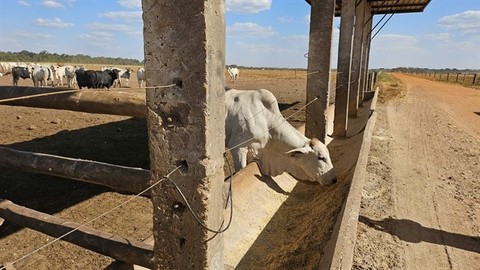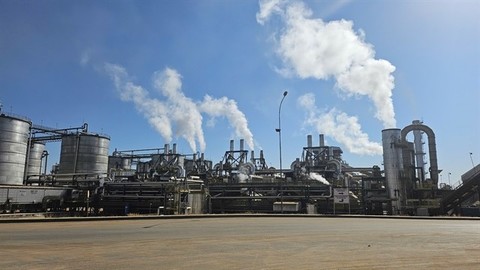Corn, the second most produced agricultural commodity in Brazil behind soybean, is unleashing new growth prospects for the country’s rural producers and boosting exports to other countries, especially Việt Nam.
During a trip to Mato Grosso, Brazil's leading state for agricultural production, a Việt Nam News reporter explored sustainable refineries that extract corn ethanol and produce distiller's dried grains with solubles (DDG/DDGS), a potential ingredient for animal nutrition.
The unique climate of Mato Grosso enables farmers to double their harvest annually, maximising yields while minimising environmental impact.
This makes the state the biggest producer of DDG and DDGS, according to data from the National Corn Ethanol Association (UNEM).
In the crop year 2024/25, DDG and DDGS production is estimated at 2.46 million tonnes, more than three times that of the second largest state producer, 0.72 million tonnes.

A DDGS warehouse of INPASA. — VNS Photo Ly Ly Cao
The byproducts of the corn ethanol production process are rich in nutrients, offering high levels of protein and energy vital for livestock.
“Our production control is monitored with the highest industrial standards, through an innovative automated process that assures stable nutritional production quality,” said Rodrigo Bicarato, export manager of INPASA, the largest corn ethanol producer in Latin America.
INPASA, founded in 2018, has invested over US$360.7 million into the refinery here, with its products witnessing a remarkable reception among local farmers, leading to a surge in demand.
DDGS from INPASA can deliver 39.6 per cent PROFAT (protein and fat) per tonne, which is higher than soybean meal.
For the domestic market, most of INPASA’s DDGS is allocated to the swine, poultry and pet sectors. The remaining is directed towards dairy cattle primarily and feedlots.

A cattle eats animal feed containing DDGS at the Passo do Lobo Farm. — VNS Photo Ly Ly Cao
At the Passo do Lobo Farm in Nova Mutum, farmers have been using INPASA's DDGS for cattle feed for the past five years.
“We are a commercial farm, so we need to pay close attention to costs and profit margins. DDGS offers a cost advantage over soybean meal and appeals to cattle due to its corn protein content,” said Florian Diez, the farm’s owner.
"We create customised feed formulas. Although the DDGS proportion varies based on individual animal needs, it is a staple in all our formulas. This significantly enhances the weight and quality of the livestock compared to other feed options.”
The cattle reared here cater not only to the domestic market but also to international customers, including to China, the European Union (EU) and Egypt.
BRF, the largest producer of animal protein and the largest exporter of poultry in Brazil, has also added DDG/DDGS to animal feed for many years.
According to BRF, with DDG/DDGS, it can double pork production while reducing the cost of animal feed, as these high-protein feeds help cut expenses for other ingredients.
Promising market
Guilherme Nolasco, CEO of the National Corn Ethanol Association (UNEM), emphasised the livestock nutrition potential of DDG/DDGS, underscoring significant export opportunities.
In 2023, Brazil commenced DDG/DDGS exports to countries including Việt Nam, New Zealand, Spain, Egypt and Turkey. According to UNEM data, Việt Nam emerged as the top buyer, representing nearly 46 per cent of the total export volume, or 255,325 tonne.
In the first five months of 2024, Việt Nam remained the primary destination for these products, with an export volume of 123,934 tonnes.
Nolasco said that UNEM's members are ramping up their production to enhance trading volumes.

An INPASA refinery in the model city Nova Mutum, Mato Grosso. — VNS Photo Ly Ly Cao
INPASA, the pioneering firm to introduce DDGS to global markets, has reported product distribution to 30 countries across Asia, the Americas and Europe.
In 2022, the company exported 273,000 tonnes of DDGS. This figure more than doubled in 2023, reaching 680,000 tonnes, with an anticipated volume of 800,000 tonnes for this year.
Specifically, it shipped 322,000 tonnes to Vietnamese market last year, accounting for 47 per cent of its total exports.
Speaking to Việt Nam News, Bicarato of INPASA said that Việt Nam stands as the company's key market focus, driven by the rapid expansion of its livestock industry and the presence of major international players such as C.P and New Hope.
Statistics from the General Department of Việt Nam Customs pointed out that the country, in general, spends around $400 million importing animal feed each month.
Bicarato said that while export quantities remain modest, Brazil is now the second largest DDGS exporter, trailing only the US.
As a result, there is more room for the products.
The company has doubled processing capacity at its refineries to increase supplies for domestic and international markets.
Victor Trenti, executive manager of FS, another major producer of corn ethanol and DDG, shared a similar positive opinion about the industry.
"Introducing our new products to customers and educating them about DDGS will require time, given their novelty in the market. However, I am optimistic about the future prospects of the product," Bicarato said.
Trenti also added that logistics pose a significant challenge due to Brazil's considerable distance from import markets and the recent rising trend of freight rates.
"Once customers grasp the efficacy of the products, they are likely to boost their orders, consequently aiding in the reduction of logistics costs,” Trenti said, adding that the company is looking for new markets like China. — VNS